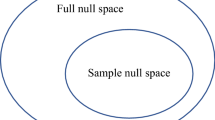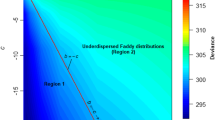Summary
Among birds of the Bismarck Archipelago, only certain combinations of the species in a guild coexist on islands, and some species that are very similar ecologically have mutually exclusive distributions. Diamond (1975) interpreted these patterns as biologically significant, involving effects such as competition. Connor and Simberloff (1979) claimed such patterns to be not recognizably different from random, because they were scarcely distinguishable from those generated by a “null” distribution supposedly not incorporating competition.
On examining the analysis by Connor and Simberloff, we find that it actually yields the opposite conclusion: three faunas tested have grossly non-random structures, while their test is unworkable for the fourth fauna. The method of Connor and Simberloff for generating a null distribution has many fatal weaknesses: dilution of relevant data from guilds with irrelevant data from the whole species pool; hidden incorporation of effects of competition into the constraints; inability to recognize a checkerboard, the extreme example of a distribution produced by competition; reliance on inefficient Monte Carlo simulations; severe constraints that sometimes make generation of a null distribution impossible; failure to weight species combinations; and failure to identify the direction of non-randomness or the species combinations most responsible.
Finally, we use other recent studies by Simberloff and coleagues to examine the value of constructing null hypotheses in community ecology.
Similar content being viewed by others
References
Beckner M (1959) The biological way of thought. Columbia Univ Press, New York
Case TJ (1982) Non-null models of community-wide character displacement. In press, Evolution
Cody ML (1978) Habitat selection and interspecific territoriality among the sylviid warblers of England and Sweden. Ecol Monogr 48:351–396
Connor EF, McCoy ED (1979) The statistics and biology of the species-area relationship. Amer Naturalist 113:791–833
Connor EF, Simberloff DS (1978) Species number and compositional similarity of the Galapagos flora and avifauna. Ecol Monogr 48:219–248
Connor EF, Simberloff DS (1979) The assembly of species communities: chance or competition? Ecology 60:1132–1140
Diamond JM (1970) Ecological consequences of island colonization by southwest Pacific birds. II. The effect of species diversity on total population density. Proc Nat Acad Sci USA 67:1715–1721
Diamond JM (1972) Biogeographic kinetics: estimation of relaxation times for avifaunas of southwest Pacific islands. Proc Nat Acad Sci USA 69:3199–3203
Diamond JM (1975) Assembly of species communities. In: Cody ML, Diamond JM (eds) Ecology and evolution of communities. Cambridge, Mass: Harvard Univ Press, p 342–444
Diamond JM (1982) Effect of species pool size on species occurrence frequencies: musical chairs on islands. Proc Nat Acad Sci USA in press
Diamond JM, Marshall AG (1977) Distributional ecology of New Hebridean birds: a species kaleidoscope. J Anim Ecol 46:703–727
Diamond JM, Mayr E (1976) Species-area relation for birds of the Solomon Archipelago. Proc Nat Acad Sci USA 73:262–266
Feinsinger P, Whelan RJ, Kiltie RA (1981) Some notes on community composition: assembly by rules or by dartboards? Bull Ecol Soc Amer 62:19–23
Gilpin ME, Diamond JM (1982) Factors contributing to non-randomness in species co-occurrences on islands. Oecologia (Berl) in press
Grant PR (1966) Ecological compatibility of bird species on islands. Amer Naturalist 100:451–462
Grant PR, Abbott I (1980) Interspecific competition, island biogeography and null hypotheses. Evolution 34:332–341
Haffer J (1969) Speciation in Amazonian forest birds. Science 165:131–137
Heatwole H, Levins R (1972) Trophic structure stability and faunal change during recolonization. Ecology 53:531–534
Hempel CG (1965) Aspects of scientific explanation. New York: Free Press
Hempel CG (1966) Philosophy of natural science. Englewood Cliffs, New Jersey: Prentice-Hall
Hull D (1974) Philosophy of biological science. Englewood Cliffs, New Jersey: Prentice-Hall
Koopman KF (1968) Taxonomic and distributional notes on Lesser Antillean bats. Amer Mus Novitates no 2333
Kuhn TS (1970) The structure of scientific revolutions. 2nd ed. Chicago: Univ of Chicago Press
MacArthur RH (1972) Geographical ecology. Harper and Row New York
Mayr E, Short LL (1970) Species taxa of North American birds. Cambridge, Mass: Nuttall Ornithological Club
Moreau RE (1966) The bird faunas of Africa and its islands. Academic Press, New York
Popper KR (1963) Conjectures and refutations: the growth of scientific knowledge. Harper and Row New York
Root R (1967) The niche exploitation pattern of the Blue-grey Gnatcatcher. Ecol Monogr 37:317–350
Roughgarden J (1982) Competition and theory in community ecology. Submitted to Amer Naturalist
Schoener TW (1976) The species-area relation within archipelagoes: models and evidence from island land birds. In: HJ Frith, JH Calaby (eds), Proceedings of the 16th International Ornithological Congress. Canberra: Australian Academy of Sciences
Simberloff DS (1970) Taxonomic diversity of island biotas. Evolution 24:23–47
Simberloff DS (1976) Trophic structure determination and equilibrium in an arthropod community. Ecology 57:395–398
Simbeloff DS (1978) Using island biogeographic distributions to determine if colonization is stochastic. Amer Naturalist 112:713–726
Strong DR Jr, Szyska LA, Simberloff DS (1979) Tests of community-wide character displacement against null hypotheses. Evolution 33:897–913
Sugihara G (1981) S-CAz, z∼1/4: a reply to Connor and McCoy. Amer Naturalist 117:790–793
Suppe F (1977) The structure of scientific theories. University of Illinois Press, Chicago
Terborgh J (1981) Discussion of a paper by Simberloff et al. In: Nelson G, Rosen DE (eds), Vicariance Biogeography. Columbia Univ Press New York p 64–68
Terborgh J, Faaborg J (1980) Saturation of bird communities in the West Indies. Amer Naturalist 116:178–195
Wilcox BA (1980) Insular ecology and conservation. In: Soulé ME, Wilcox BA (eds), Conservation Biology. Sunderland, Mass: Sinauer, p 95–117
Williams CB (1964) Patterns in the balance of nature and related problems in quantitative ecology. Academic Press, New York
Wright SJ, Biehl CC (1981) Insular distributions: testing for chance and competition. Submitted to Amer Naturalist
Author information
Authors and Affiliations
Rights and permissions
About this article
Cite this article
Diamond, J.M., Gilpin, M.E. Examination of the “null” model of connor and simberloff for species co-occurrences on Islands. Oecologia 52, 64–74 (1982). https://doi.org/10.1007/BF00349013
Received:
Issue Date:
DOI: https://doi.org/10.1007/BF00349013




